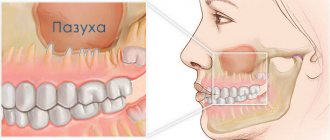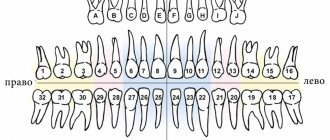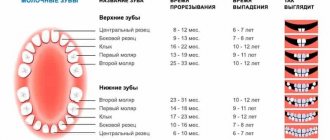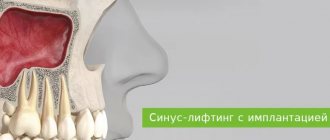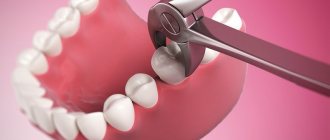Types of infections
Dentists divide diseases based on their development:
- truly odontogenic. They are caused by a problem tooth. If caries, pulpitis, periodontitis, inflammation are not cured in time, the infection begins to spread further;
- non-odontogenic. The reason is damage to the oral mucosa;
- periodontal. Advanced problems with the gums, periosteum or soft tissues of the neck are to blame for the occurrence of such infections.
Whole groups of microorganisms can be causative agents of infection: viridans streptococci, spirochetes, non-spore-forming anaerobes.
Treatment
Treatment of sinusitis of odontogenic origin requires preliminary thorough diagnosis; our Center has everything necessary for it: computed tomography, x-ray, puncture examination. Treatment of sinusitis is surgical, performed using local anesthesia or, if necessary and at the discretion of the doctor, under general anesthesia. The Center for Maxillofacial Surgery and Implantology (Moscow) has a special license for treatment and operations under general anesthesia, including the treatment of sinusitis. The center has its own hospital, equipped with modern operating rooms and comfortable wards for postoperative rest and recovery after treatment. Modern medical, diagnostic and anesthesiological equipment, as well as extensive experience in the treatment of sinusitis and highly qualified doctors, allow us to successfully treat sinusitis of the upper jaw of odontogenic origin of any complexity.
For odontogenic maxillary sinusitis, treatment is performed in several stages: the dental surgeon removes the tooth that caused the disease. Then the ENT doctor begins treatment with antibiotics, antiseptics and enzymes.
In the absence of treatment for sinusitis, it can become chronic and periodically renew pain, swelling, nasal congestion and other symptoms listed above. Chronic odontogenic maxillary sinusitis can lead to even more severe complications that will require surgery and longer treatment. Without timely and complete treatment of chronic sinusitis (sinusitis), the inflammatory process can spread to other sinuses, the periosteum or bone of the upper jaw, as well as to the orbital area. To prevent these complications, treatment is not limited to removing the causative tooth, since the inflammation spreads to a significant surface of the maxillary sinus. Pathological changes in the sinus caused by sinusitis are removed surgically under general anesthesia.
Causes of development of odontogenic infections
More often, diseases spread and develop due to patients’ inattention to their health. The reasons are:
- infrequent visits to the dentist. Even if nothing worries you, you need to undergo medical examinations every six months. Professional oral hygiene in a dental clinic removes plaque, tartar, restores the natural shade of enamel and prevents the occurrence of caries and gum problems;
- poor hygiene and bad habits. When a patient does not spend enough time brushing his teeth, does not use dental floss, and self-medicates instead of visiting a specialist, the condition of the oral cavity worsens. Smoking and drinking alcohol have a bad effect on the gums: the tissue becomes thinner, becomes inflamed and begins to bleed;
- unsuccessful dental operations. Serious problems can result from an incorrectly placed filling, traumatic tooth extraction, incompletely cured caries or other disease.
Your dentist will help determine the cause. The specialist will also give recommendations on how to avoid problems in the future.
results
In 29 cases (90.7%) the result of OA was sinusitis, in 2 - palatal abscess (6.2%) and canine fossa abscess (3.1%). The cervical-fascial spaces were involved as follows: submental space in 2 cases (16.7%), submandibular in 7 cases (58.3%), sternocleidomastoid region in 2 cases (16.7%), and peripharyngeal with descending spread into the mediastinum in one (8.3%).
Causes of OI included tooth extraction (7 cases - 15.9% overall), installation of implants (13 cases - 29.6%), caries (12 cases - 27.3%), eruption anomalies (8 cases - 18.2% ), endodontic manipulations (2 cases - 4.5%), as well as sinus lifting (2 cases -4.5%). They are also divided into complications of pre-implantology (2 cases - 4.5%) or implantology treatment (13 cases - 29.6%), consequences of “classical” dental procedures (i.e. tooth extraction, endodontics), caries or eruption anomalies ( 29 cases - 65.9%), according to the proposal of Felisati's classification [11].
Microbiological cultures of surgical specimens were negative in 5 cases (11.4%) or showed nonspecific growth of mixed oropharyngeal flora (OP) in 12 cases (27.2%). Thus, antibiotic therapy was used in most patients. Three (6.8%) purely mycotic infections (Aspergillus spp) were observed as mycetomas of the maxillary sinus.
Cervical surgical drainage with removal of necrotic tissue in combination with dental procedures aimed at eliminating concomitant dental pathologies was used in all cases of detection of oropharyngeal flora (12 cases). Recurrent infection developed in one case after surgery (ie, parapharyngeal abscess as a consequence of long-standing, untreated caries), with retropharyngeal and subsequent descending mediastinal spread. The patient required additional thoracotomy and an extended stay in the intensive care unit.
Conversely, in case of upper segment OI (32 patients), access was created through a functional endoscopic transnasal approach in 11 cases (34.4%) or using a combination of FEC and the Caldwell-Luc approach (18 cases - 56.2%). Three upper ROIs (two hard palate abscesses and one canine fossa abscess - 9.4%) were eliminated by transoral surgical drainage without FEC.
Signs of infection and patients at risk
Main symptoms:
- I constantly have a high temperature and a headache. These are signs of intoxication of the body;
- notice a purulent focus. Redness appears around, the affected area swells and hurts.
Problems also begin in the neck area: the throat hurts, the tongue swells, it becomes difficult to breathe and speech is distorted. Often with such complaints they go to a general surgeon. The doctor helps eliminate the consequences of the infection, but the outbreak still remains, and the disease continues to spread through the vessels and affect the tissues.
People with weak immunity are considered the most vulnerable to odontogenic infections: patients with oncology, hepatitis, HIV, diabetes. By age group, children and patients over 60 years of age are at greatest risk. Chemotherapy and drugs that suppress the immune system also weaken the body.
Symptoms of odontogenic sinusitis
Most often patients complain of:
- moderate pain in the cheek or infraorbital region (sometimes the entire half of the face hurts);
- nasal congestion on one side only, feeling of heaviness;
- discharge of pus from the corresponding half of the nose;
- pain when biting on an incorrectly treated tooth;
- dysfunction of the sense of smell;
- feeling unwell – headache, fever, sleep disturbance, chills;
- With an exacerbation of the disease, enlargement of the lymph nodes on the corresponding side is possible.
How are odontogenic infections treated?
The dentist begins with sanitation of the oral cavity, then carefully opens the abscess. Treatment of dental infections is carried out using different methods depending on the degree of complexity and location of the outbreak. One of the principles is to provide air flow, which will kill pathogens.
If the abscess is too deep in the tissues, the process is monitored using ultrasound. Patients are required to be given antibiotics. Then they are combined with antimicrobial drugs. General strengthening therapy is also used.
If the infection is not treated in time, you may encounter complications:
- purulent inflammations,
- blockage of veins,
- sinusitis,
- damage to the lymph nodes,
- sepsis.
To avoid odontogenic infections, visit your dentist regularly, do not delay treatment, and carefully monitor your oral health.
Discussion
The oral cavity is an anatomical region with a high presence of bacteria. For example, the number of microorganisms in a periodontal pocket can reach 1.8 x 1011/g of material [12]. Therefore, all oral procedures should be performed to minimize the risk of secondary infections and possible systemic bacterial spread.
OIs are often encountered in everyday dental practice, especially in adults: odontogenic pathogenesis is detected in 10-30% of cases of sinusitis [2] and in almost 50% of cases of cervical-fascial infections [6]. However, their prevalence remains largely underestimated due to their nonspecific clinical presentation compared to their nonodontogenic counterparts and unpredictable course [2, 6].
As stated previously, OIs are potentially invasive complications due to the proximity of the oral region to other anatomical spaces of the head and neck, namely the paranasal sinuses (superior OI) and the deep cervicofascial spaces (inferior OI) [2-7]. In our sample, the main causes of OI were implantation (13/44, 29.6%) and caries (12/44, 27.3%), followed by eruption anomalies (8/44, 18.2%), tooth extraction (7/ 44, 15.9%), endodontic procedures (2/44, 4.5%) and sinus lift (2/44, 4.5%). However, stratifying the pathogenesis by the areas involved, implantation becomes predominant when determining OH (11/32, 34.4%), and caries - when involving the cervical-fascial spaces (7/12, 58.3%). This conclusion is consistent with literature data [6, 13].
The use of implants for rehabilitation has increased significantly in recent years. This type of rehabilitation is very useful and successful, also in immunocompromised patients [14], but implantation is not always easy or safe to perform, especially by inexperienced surgeons [4]. Superior displacement of the implant (Fig. 1 a, b) may, in fact, perforate Schneiderian membrane, leading to a foreign body reaction and altering sinonasal mucociliary clearance. Thus, stasis of inflammatory components within the sinus causes OH [14, 15]. A similar condition easily occurs with an atrophic alveolar process [13, 16] or with concomitant sinonasal pathology (i.e., decreased patency of the nasal passages due to deformation of the septum, turbinates, cribriform plate) (14). Moreover, even a well-placed implant in a patient with major risk factors (eg, pre-existing sinonasal pathology, diabetes, malnutrition, smoking, steroid therapy, osteoporosis) can lead to OI [1], as can failed pre-implant procedures [4, 14]. , 17]. Indeed, sinus lifting with bone graft can lead to severe OI [4, 14, 17].
Rice. 1 a. The upper implant is displaced into the cavity of the maxillary sinus.
Rice. 1 b. The upper implant is displaced into the cavity of the maxillary sinus.
While many dentists are aware of the possible complications after implant placement, caries and eruption abnormalities are largely underestimated. However, these are common causes of OI, as confirmed by the study results. When caries remains untreated for a long time, the bacterial load is high and underlying conditions exist (eg, caries, periodontal disease, diabetes, immunosuppression), spread of infection from the dental hard tissues into the pulp and periodontal tissues may occur, facilitating subsequent diffusion through the alveolar bone into the cervical fascial spaces [6, 18]. The same applies to eruption anomalies [19] (Fig. 1c, d), which can contribute to OH, cyst formation and granulomatous inflammatory response [20] or traumatic injuries associated with the extraction of affected teeth [16, 21]. The deep spaces of the neck, in particular, are potential areas of low resistance that fill with inflammatory exudate and pus in the event of infection, causing airway narrowing, descending mediastinal or systemic spread, erosion of large blood vessels and life-threatening thrombosis/hemorrhage, with significant mortality up to 40% of cases [6].
Rice. 1st century Molars in the maxillary sinus cavity (white arrows), a clear example of eruption anomalies in the maxilla.
Rice. 1 g. Molars in the cavity of the maxillary sinus (white arrows), a clear example of eruption anomalies in the upper jaw.
Tooth extraction can also cause OI [11, 12, 22]. If not performed correctly, this procedure can lead to alveolitis, displacement of the tooth root into the maxillary sinus (Fig. 2) [11, 12, 22]. Risk factors include the presence of radiating roots, dental caries, and large fillings, as these conditions may contribute to tooth fracture [22].
Rice. 2 a. An endoscopic probe approaching an oroantral fistula resulting from improper tooth extraction.
Rice. 2 b. Purulent discharge from the fistula as a result of the insertion of a probe.
Another cause of OI (especially OH) is endodontics, the materials or instruments of which can exit the apex of the root canal, reaching the maxillary sinus. This often results in fungal colonization of the sinus, with fungal granuloma being the most common clinical manifestation [23–25]. In our series, we observed 3 mycetomas of the maxillary sinus (Fig. 3) as a result of unsuccessful endodontic procedures (2/3) or implant placement (1/3).
Rice. 3 a. Mycetoma of the maxillary sinus resulting from unsuccessful endodontics.
Rice. 3 b. Removal of mycetoma followed by drainage of the sinus.
Rice. 3rd century Typical CT scan for complete inflammatory obliteration of the sinus.
Rice. 3 g. Fungal colonization sample.
Rice. 4 a. Periapical periodontitis on the lower jaw on the right with an accompanying abscess spreading from the submandibular space to the buccal space.
Rice. 4 b. Periapical periodontitis on the lower jaw on the right with an accompanying abscess spreading from the submandibular space to the buccal space.
The etiologies of our OIs are consistent with other studies known in the literature [26, 27]: alpha-hemolytic streptococcus was most often found in purulent contents (9/44, 20.6%), followed by beta-hemolytic streptococcus (S. pyogenes and S. agalactiae; 6/44, 13.6%), gram-negative species (K. pneumoniae, E. corrodens and Enterobacter spp; 6/44, 13.6%), Staphylococcus aureus (4/44, 9.1%) and obligate anaerobes (2/44, 4.5% ). Pathological samples did not yield growth in 5 cases (11.4%), nonspecific mixed oropharyngeal flora was isolated in 12 cases (27.2%); this circumstance is not unusual [26, 27], since OIs are often polymicrobial [2]. This makes the choice of antibiotic particularly difficult and necessitates the need for combination, intravenous therapy with broad-spectrum antibiotics.
As for OI of the cervicopharyngeal spaces, several “red flags” almost always need to be noted in treatment: rapid progressive edema, worsening of the trismus, dyspnea/tachypnea, dysphonia, dysphagia, pyrexia or neck stiffness - all these are clear signs of a complex course and should be promptly addressed eliminated to avoid deterioration and risk of death [6, 7]. In our sample, there was a case of recurrent infection after successful drainage of a parapharyngeal abscess with retropharyngeal and subsequent descending mediastinal spread. A multimodal approach and prolonged intensive care unit stay with aggressive intravenous therapy were required. Timely detection of worsening clinical course was necessary to save the patient. A high index of suspicion should always be maintained when treating OI of the cervicopharyngeal spaces, even after apparently successful drainage: vital signs, temperature, complete blood count, neck palpation and laryngoscopy should be repeated regularly in the postoperative period [6, 7].
Odontogenic sinusitis often requires the creation of several surgical approaches (transnasal endoscopic approach in combination with transoral) [11]. In our sample, this circumstance occurred in half of the cases (16/32, 50.0%). The Caldwell-Luc approach has now been practically abandoned due to greater trauma, and is performed in the presence of large foreign bodies in the cavity of the maxillary sinus [28, 29]. In fact, we used this procedure in few cases [2/32, 6.2%].
What is the danger of the disease
Without proper treatment, a chronic inflammatory process with pathogenic microflora develops in the sinus, destroying the sinus mucosa and surrounding bone tissue. Since the maxillary sinuses are located close to anatomically important structures, severe complications can arise:
- Orbital The upper wall of the sinus is in contact with the lower wall of the eye orbit. The infection spreads into the orbit with the formation of an abscess and phlegmon. As a result, optic nerve neuritis develops, deterioration or complete loss of vision.
- Intracranial The most dangerous complications associated with the penetration and impact of infection on the brain. Meningitis, encephalitis, and abscess develop. If detected and treated untimely, irreversible consequences, including death, can occur.
Foci of infection provoked by the presence of a foreign body can cause a precancerous condition.
How to avoid
There are only two ways to prevent the development of odontogenic sinusitis:
- Treat your teeth in a timely manner, prevent infection of the dental canals and spread of inflammation beyond the apex of the tooth root.
- Contact proven clinics with experienced doctors, the opportunity to conduct a thorough diagnosis and provide for an emergency situation.
In our Center, not a single dental procedure, especially at the border with the maxillary sinuses, is performed without a thorough X-ray examination using a computed tomograph.
The study is carried out using
a high-precision Sirona device with the Galileos diagnostic software package.
Based on the results of computed tomography, we determine the location of the roots and the size of the bone septum. This makes it possible to plan treatment in such a way as to avoid risks.
Tooth extraction operations and other interventions in the area of the maxillary sinuses in our Center are performed only by maxillofacial surgeons with ENT training . Deep knowledge of the anatomy of the maxillary region allows you to avoid mistakes that a regular dentist might make. But each case is individual, and even if something goes wrong, our doctors are always ready for any turn of events and correct the situation.
Why you should entrust treatment to the ENT department of dentistry
ENT dentistry is a symbiosis of two medical areas, a multidisciplinary approach to the treatment of inflammation of the maxillary sinuses of odontogenic origin. Only an experienced maxillofacial surgeon with ENT training can make an accurate diagnosis and create a sound rehabilitation plan.
As a rule, odontogenic causes of sinusitis are simply ignored during routine examination by an otolaryngologist. Treatment in a city clinic without high-quality diagnostics or in the absence of it at all turns into a multi-part series with monthly visits to an ENT doctor, dragging on for many years, causing inconvenience and worsening the quality of life.
Unified drug therapy or traumatic sinus punctures are prescribed, which, if they bring relief, are for a short time. Inflammation from the acute stage becomes chronic with periodic exacerbations. A person runs from one doctor to another to no avail, but without identifying and eliminating the cause, odontogenic sinusitis cannot be cured !
